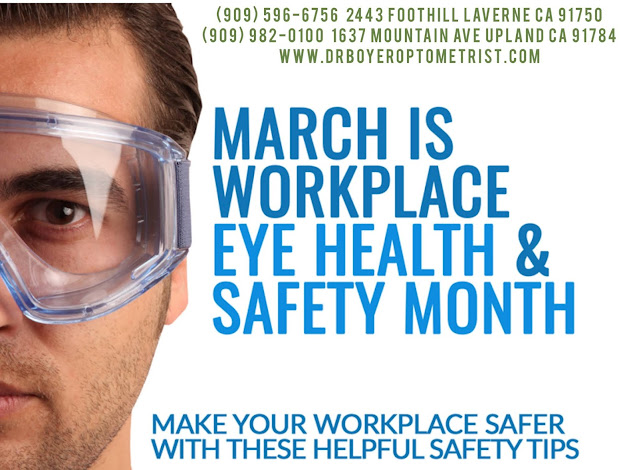Eye injuries in the workplace are very common. The National Institute for Occupational Safety and Health (NIOSH) reports about 2,000 U.S. workers sustain job-related eye injuries that require medical treatment each day. However, safety experts and eye doctors believe the right eye protection could have lessened the severity or even prevented 90% of these eye injuries.
Simply using the proper eye protection on the job could prevent thousands of eye injuries each year.
Common eye injuries occurring at work can result from chemicals or foreign objects in the eye and cuts or scrapes on the cornea. Other causes of injuries include splashes with grease and oil, burns from steam, ultraviolet or infrared radiation exposure, and flying wood or metal chips.
In addition, health care workers, laboratory and janitorial staff, and other workers may be at risk of acquiring infectious diseases from eye exposure. Some infectious diseases can be transmitted through the mucous membranes of the eye as a result of direct exposure to blood splashes, respiratory droplets generated during coughing, or from touching the eyes with contaminated fingers or other objects.
Two major reasons workers experience eye injuries on the job are because they were:
- Not wearing eye protection, or
- Wearing the wrong kind of protection for the job.
A Bureau of Labor Statistics (BLS) survey of workers who suffered eye injuries revealed that nearly three out of five were not wearing eye protection at the time of the accident. These workers most often reported that they believed protection was not required for the situation.
The Occupational Safety and Health Administration (OSHA) requires the use of eye and face protection whenever there is a reasonable probability of injury that could be prevented by such equipment. Personal protective eyewear, such as goggles, face shields, safety glasses, or full face respirators must be used when an eye hazard exists. The eye protection chosen for specific work situations depends upon the type of hazard, the circumstances of exposure, other protective equipment used, and individual vision needs.
What are the potential eye hazards at work?
Potential eye hazards against which protection is needed in the workplace are:
- Projectiles (dust, concrete, metal, wood and other particles)
- Chemicals (splashes and fumes)
- Radiation (especially visible light, ultraviolet radiation, heat or infrared radiation, and lasers)
- Bloodborne pathogens (hepatitis or HIV) from blood and body fluids
- Non-prescription and prescription safety glasses — Although safety glasses may look like normal dress eyewear, they are designed to provide significantly more eye protection. They have lenses and frames that are much stronger than regular eyeglasses. Safety glasses must meet standards of the American National Standards Institute (ANSI). Look for the Z87 mark on the lens or frame.
- Safety glasses provide eye protection for general working conditions where there may be dust, chips or flying particles. Additional side protection can be provided by the use of side shields and wraparound-style safety glasses.
- Safety lenses are available in glass, plastic, polycarbonate and Trivex™ materials. While all four types must meet or exceed the minimum requirements for protecting your eyes, polycarbonate lenses provide the highest level of protection from impact.
The shield provided by goggles protects eyes from chemical splashes and ocular exposure to bloodborne pathogens.
- Goggles — Goggles provide impact, dust and chemical splash protection. Like safety glasses, safety goggles are highly impact resistant. In addition, they provide a secure shield around the entire eye and protect against hazards coming from any direction.
- Goggles can be worn over prescription glasses and contact lenses to provide protection from flying objects and chemical splashes and in dusty environments.
- Face shields and helmets — Full face shields are used to protect workers exposed to chemicals, heat, or bloodborne pathogens. Helmets are used for welding or working with molten materials. Face shields and helmets should not be used as the sole means of protective eyewear. They need to be used in conjunction with safety glasses or goggles. Wearing safety glasses or goggles under face shields also provides protection when the shield is lifted.
- Special protection — Other types of protection, such as helmets or goggles with special filters to protect the eyes from optical radiation exposure, should be used for tasks such as welding or working with lasers.
Schedule a visit with our Doctors and opticians to find the best possible safety options for your job and workplace Make your appointment today. (909) 596-6756 2443 Foothill LaVerne CA 91750 (909) 982-0100 1637 Mountain Ave Upland CA 91784 #drkennethboyerOD #drbrianboyerOD #eyesafetyawarenessmonth #workplaceeyewellnessmonth www.drboyeroptometrist.com





